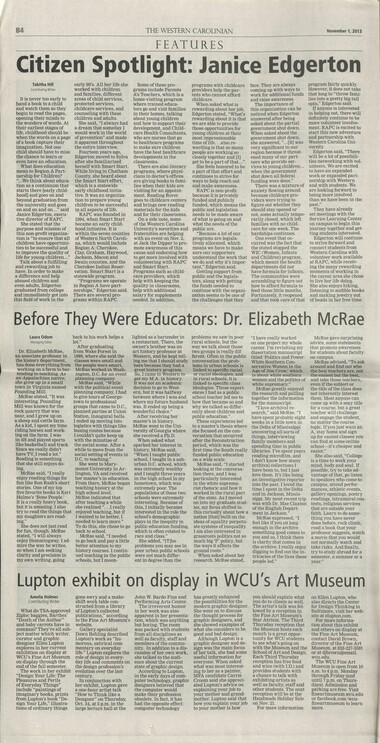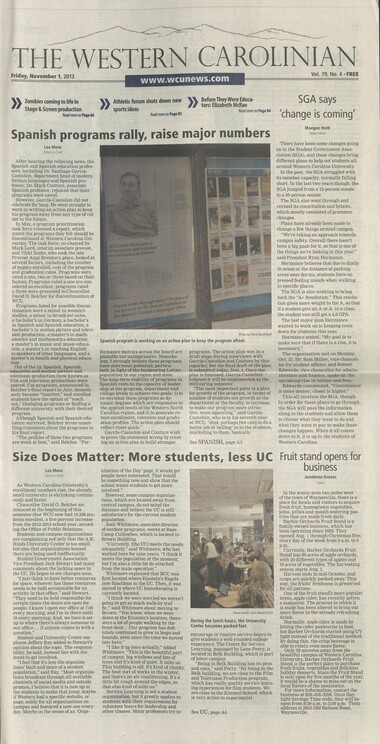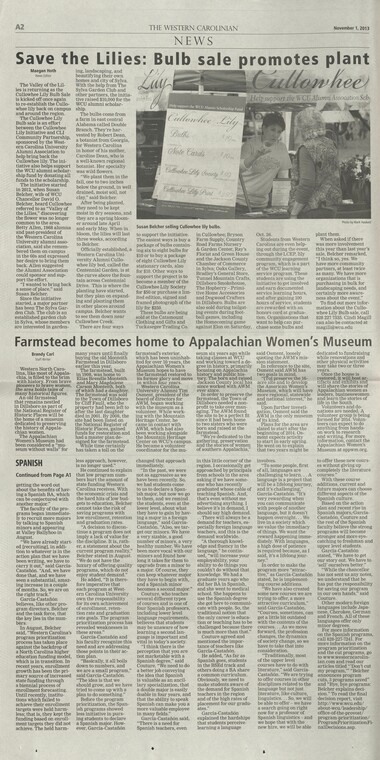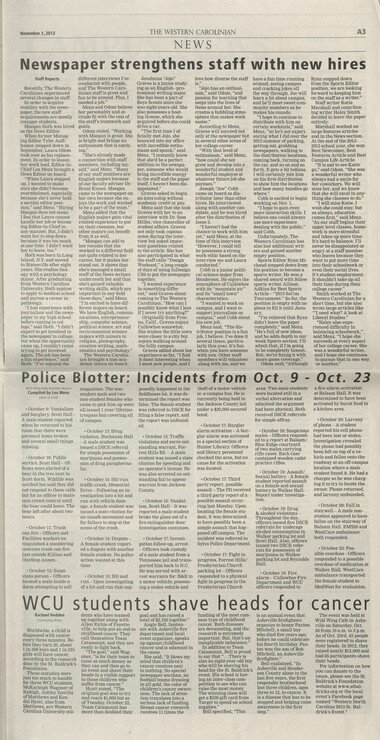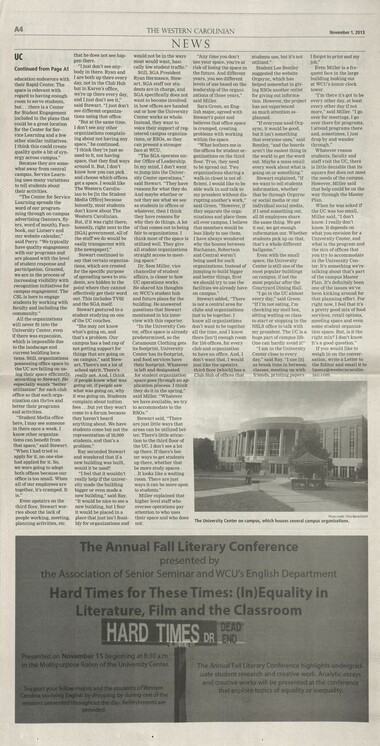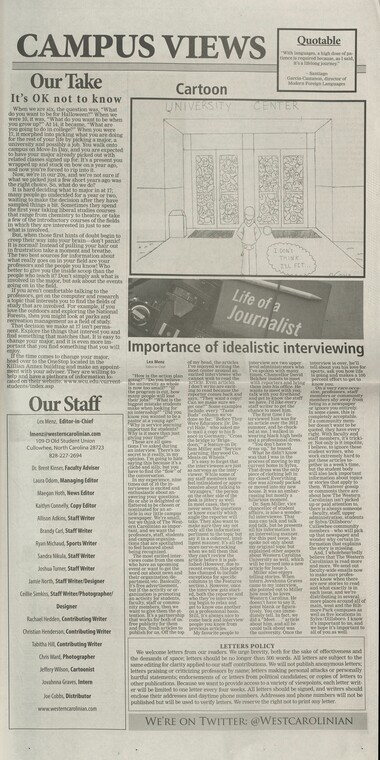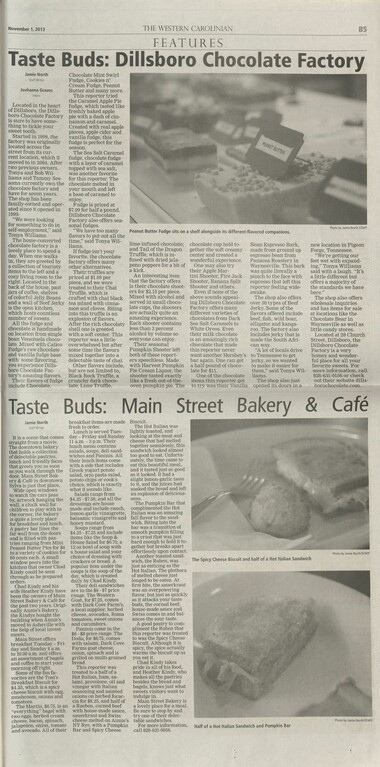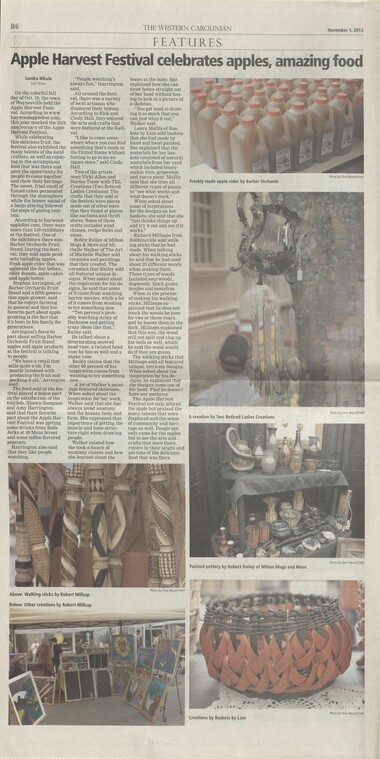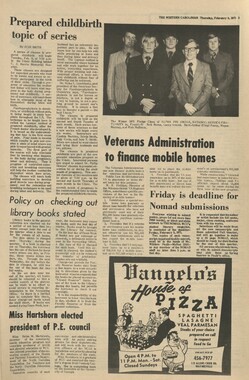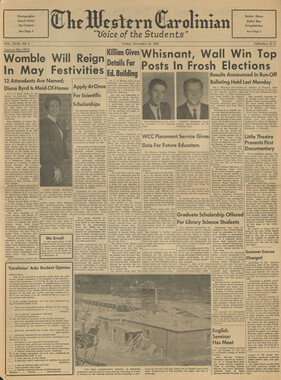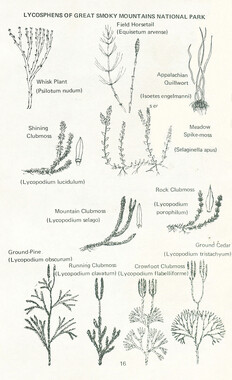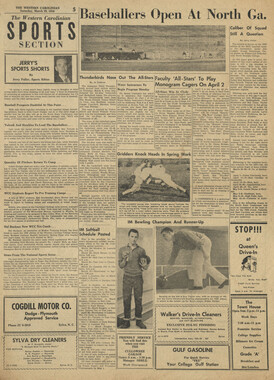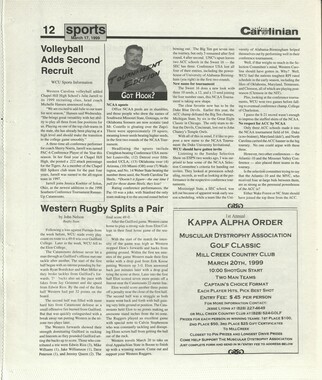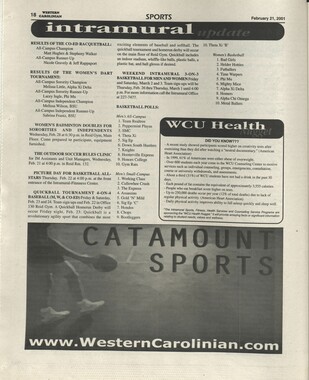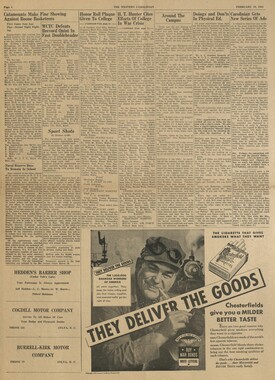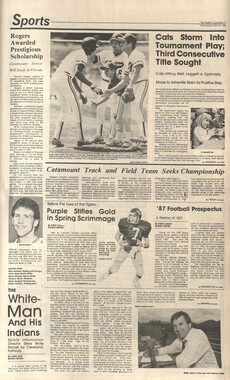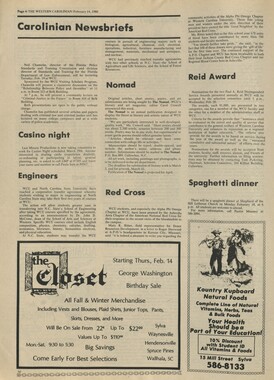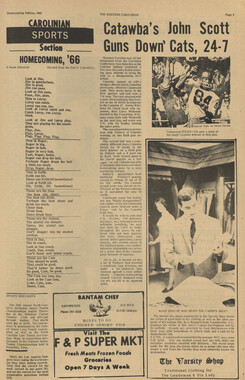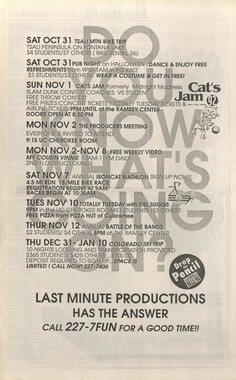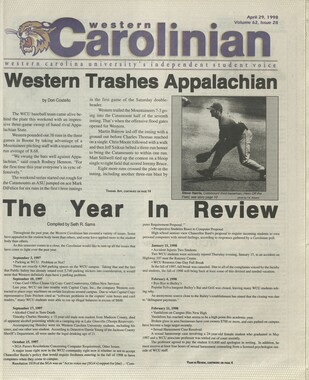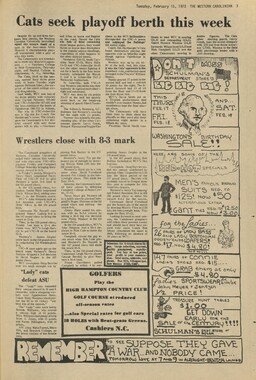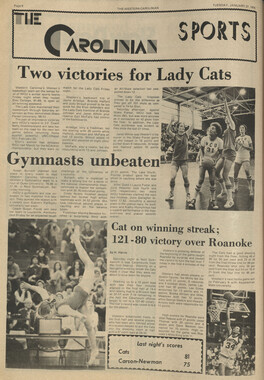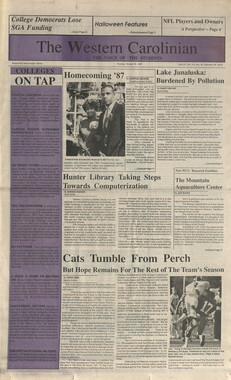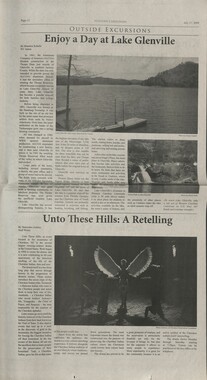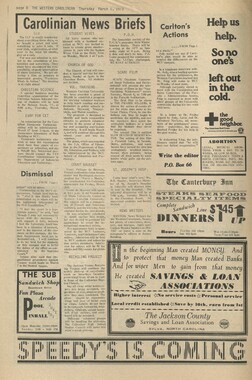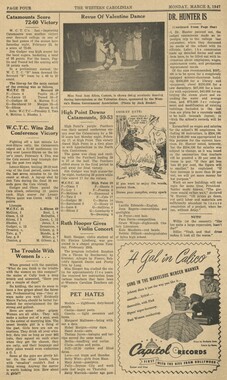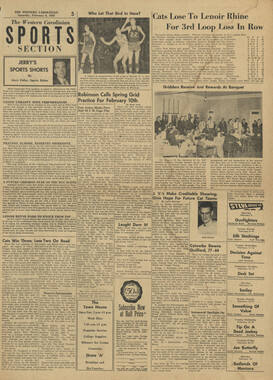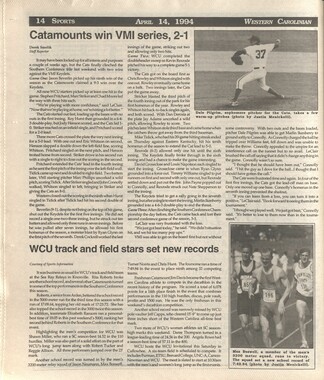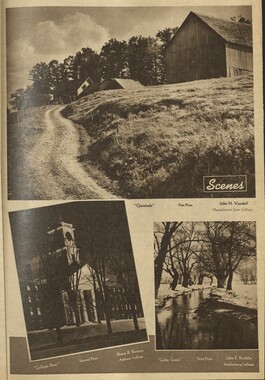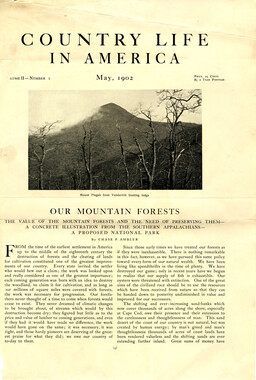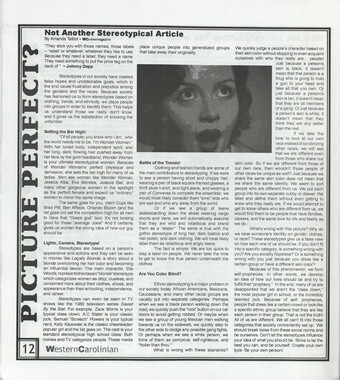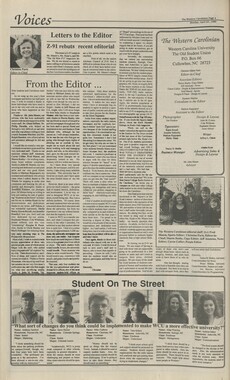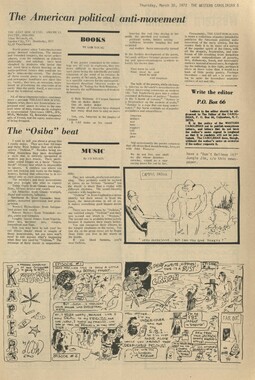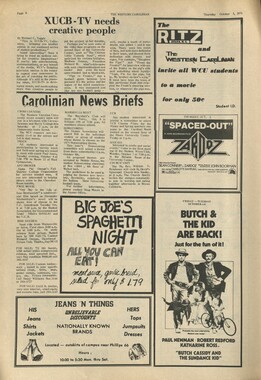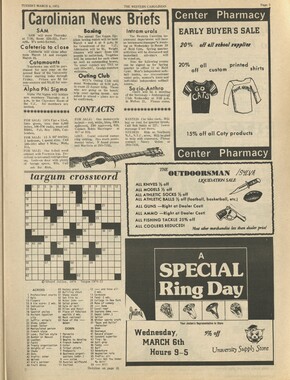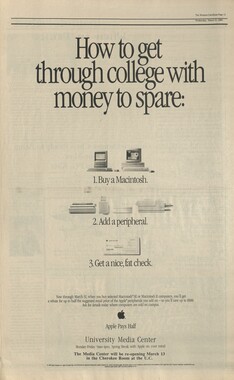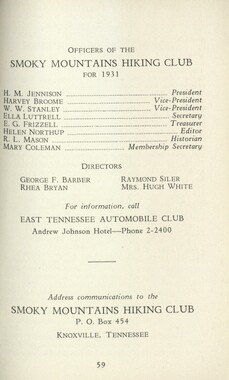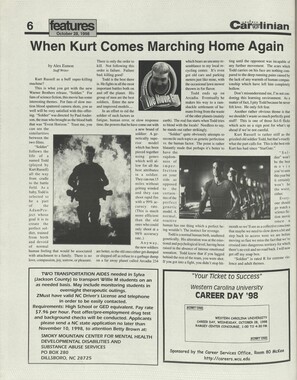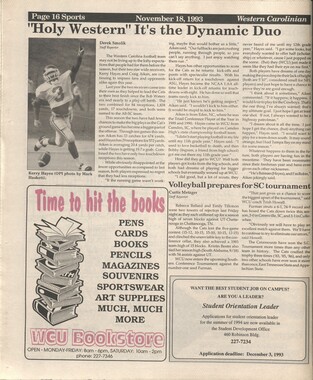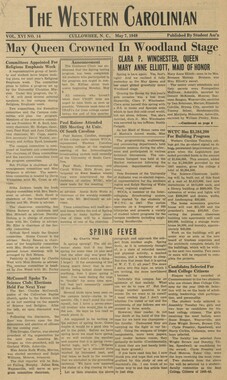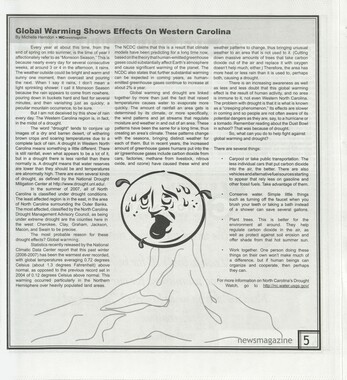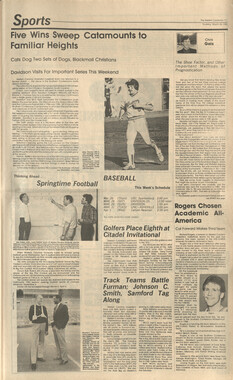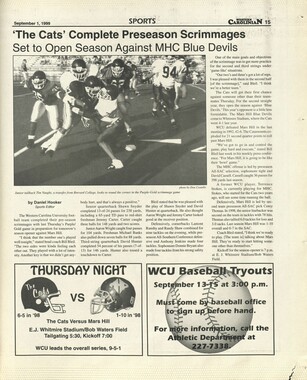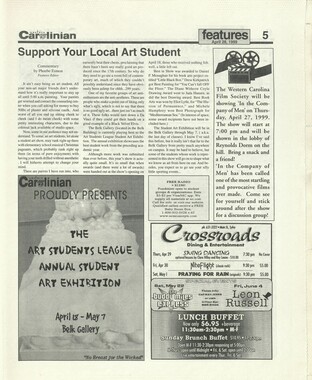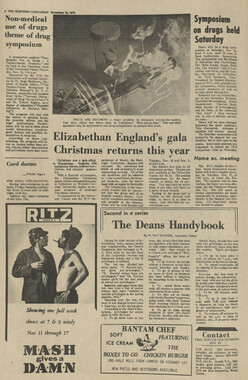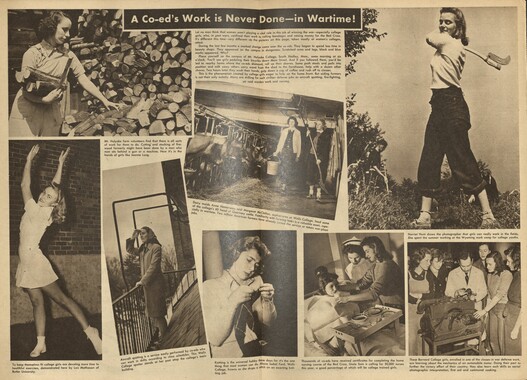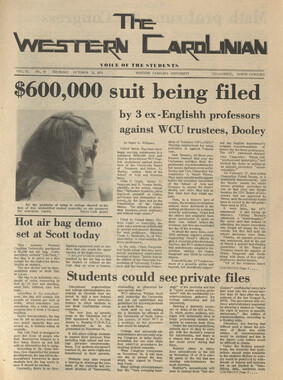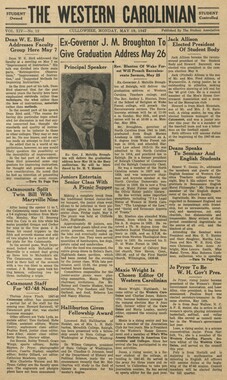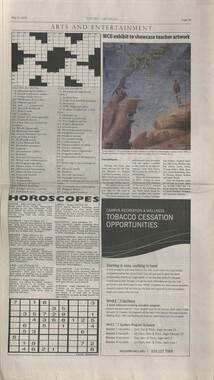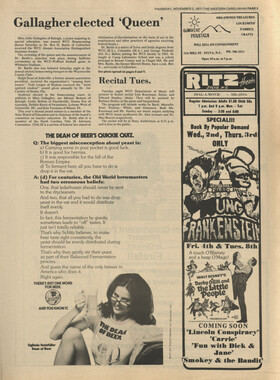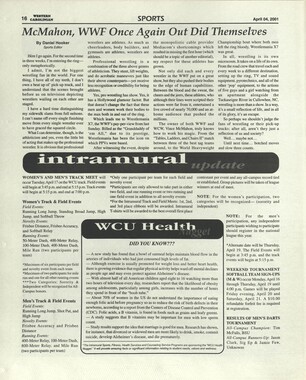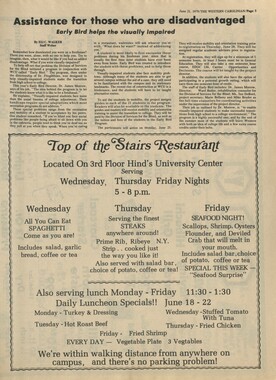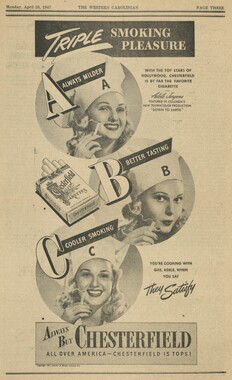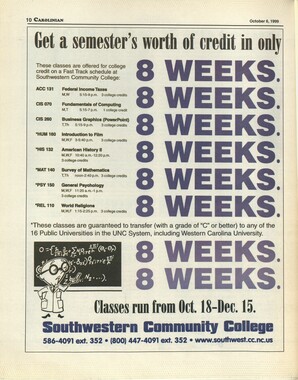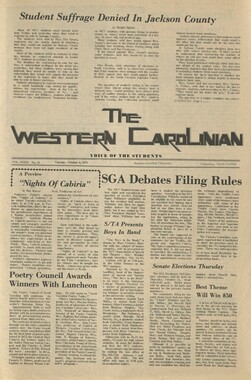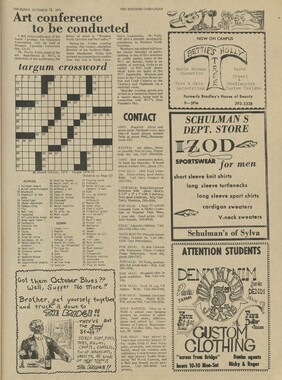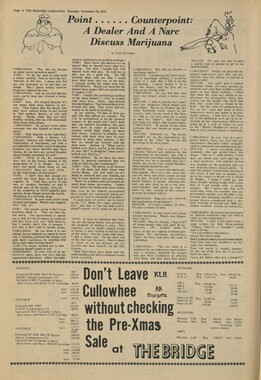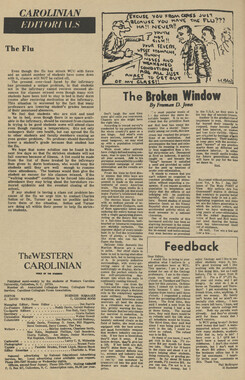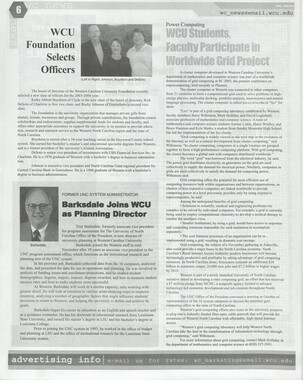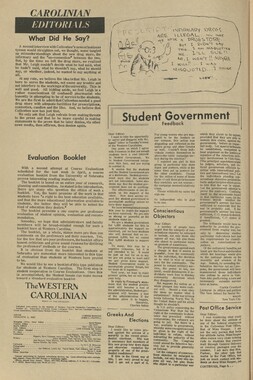Western Carolina University (21)
View all
- Canton Champion Fibre Company (2308)
- Cherokee Traditions (291)
- Civil War in Southern Appalachia (165)
- Craft Revival (1942)
- George Masa Collection (137)
- Great Smoky Mountains - A Park for America (2900)
- Highlights from Western Carolina University (422)
- Horace Kephart (973)
- Journeys Through Jackson (159)
- LGBTQIA+ Archive of Jackson County (85)
- Oral Histories of Western North Carolina (316)
- Picturing Appalachia (6797)
- Stories of Mountain Folk (413)
- Travel Western North Carolina (153)
- Western Carolina University Fine Art Museum Vitreograph Collection (129)
- Western Carolina University Herbarium (92)
- Western Carolina University: Making Memories (738)
- Western Carolina University Publications (2491)
- Western Carolina University Restricted Electronic Theses and Dissertations (146)
- Western North Carolina Regional Maps (71)
- World War II in Southern Appalachia (131)
University of North Carolina Asheville (6)
View all
- Allanstand Cottage Industries (62)
- Appalachian National Park Association (53)
- Bennett, Kelly, 1890-1974 (1463)
- Berry, Walter (76)
- Brasstown Carvers (40)
- Carver, George Washington, 1864?-1943 (26)
- Cathey, Joseph, 1803-1874 (1)
- Champion Fibre Company (233)
- Champion Paper and Fibre Company (297)
- Cherokee Indian Fair Association (16)
- Cherokee Language Program (22)
- Crowe, Amanda (40)
- Edmonston, Thomas Benton, 1842-1907 (7)
- Ensley, A. L. (Abraham Lincoln), 1865-1948 (275)
- Fromer, Irving Rhodes, 1913-1994 (70)
- George Butz (BFS 1907) (46)
- Goodrich, Frances Louisa (120)
- Grant, George Alexander, 1891-1964 (96)
- Heard, Marian Gladys (60)
- Kephart, Calvin, 1883-1969 (15)
- Kephart, Horace, 1862-1931 (313)
- Kephart, Laura, 1862-1954 (67)
- Laney, Gideon Thomas, 1889-1976 (439)
- Masa, George, 1881-1933 (61)
- McElhinney, William Julian, 1896-1953 (44)
- Niggli, Josephina, 1910-1983 (10)
- North Carolina Park Commission (105)
- Osborne, Kezia Stradley (9)
- Owens, Samuel Robert, 1918-1995 (11)
- Penland Weavers and Potters (36)
- Roberts, Vivienne (15)
- Roth, Albert, 1890-1974 (142)
- Schenck, Carl Alwin, 1868-1955 (1)
- Sherrill's Photography Studio (2565)
- Southern Highland Handicraft Guild (127)
- Southern Highlanders, Inc. (71)
- Stalcup, Jesse Bryson (46)
- Stearns, I. K. (213)
- Thompson, James Edward, 1880-1976 (226)
- United States. Indian Arts and Crafts Board (130)
- USFS (683)
- Vance, Zebulon Baird, 1830-1894 (1)
- Weaver, Zebulon, 1872-1948 (58)
- Western Carolina College (230)
- Western Carolina Teachers College (282)
- Western Carolina University (2008)
- Western Carolina University. Mountain Heritage Center (18)
- Whitman, Walt, 1819-1892 (10)
- Wilburn, Hiram Coleman, 1880-1967 (73)
- Williams, Isadora (3)
- Cain, Doreyl Ammons (0)
- Crittenden, Lorraine (0)
- Rhodes, Judy (0)
- Smith, Edward Clark (0)
- Appalachian Region, Southern (2940)
- Asheville (N.C.) (1944)
- Avery County (N.C.) (26)
- Blount County (Tenn.) (195)
- Buncombe County (N.C.) (1680)
- Cherokee County (N.C.) (283)
- Clay County (N.C.) (556)
- Graham County (N.C.) (238)
- Great Smoky Mountains National Park (N.C. and Tenn.) (525)
- Haywood County (N.C.) (3573)
- Henderson County (N.C.) (70)
- Jackson County (N.C.) (4919)
- Knox County (Tenn.) (35)
- Knoxville (Tenn.) (13)
- Lake Santeetlah (N.C.) (10)
- Macon County (N.C.) (421)
- Madison County (N.C.) (216)
- McDowell County (N.C.) (39)
- Mitchell County (N.C.) (135)
- Polk County (N.C.) (35)
- Qualla Boundary (982)
- Rutherford County (N.C.) (78)
- Swain County (N.C.) (2185)
- Transylvania County (N.C.) (270)
- Watauga County (N.C.) (12)
- Waynesville (N.C.) (86)
- Yancey County (N.C.) (72)
- Aerial Photographs (3)
- Aerial Views (60)
- Albums (books) (4)
- Articles (1)
- Artifacts (object Genre) (228)
- Bibliographies (1)
- Biography (general Genre) (2)
- Cards (information Artifacts) (38)
- Clippings (information Artifacts) (192)
- Copybooks (instructional Materials) (3)
- Crafts (art Genres) (622)
- Depictions (visual Works) (21)
- Design Drawings (1)
- Digital Moving Image Formats (2)
- Drawings (visual Works) (185)
- Envelopes (101)
- Exhibitions (events) (1)
- Facsimiles (reproductions) (1)
- Fiction (general Genre) (4)
- Financial Records (12)
- Fliers (printed Matter) (67)
- Glass Plate Negatives (381)
- Guidebooks (2)
- Internegatives (10)
- Interviews (817)
- Land Surveys (102)
- Letters (correspondence) (1045)
- Manuscripts (documents) (618)
- Maps (documents) (177)
- Memorandums (25)
- Minutes (administrative Records) (59)
- Negatives (photographs) (6090)
- Newsletters (1290)
- Newspapers (2)
- Notebooks (8)
- Occupation Currency (1)
- Paintings (visual Works) (1)
- Pen And Ink Drawings (1)
- Periodicals (193)
- Personal Narratives (10)
- Photographs (12976)
- Plans (maps) (1)
- Poetry (6)
- Portraits (4568)
- Postcards (329)
- Programs (documents) (181)
- Publications (documents) (2444)
- Questionnaires (65)
- Relief Prints (26)
- Sayings (literary Genre) (1)
- Scrapbooks (282)
- Sheet Music (2)
- Slides (photographs) (402)
- Songs (musical Compositions) (2)
- Sound Recordings (796)
- Specimens (92)
- Speeches (documents) (18)
- Tintypes (photographs) (8)
- Transcripts (324)
- Text Messages (0)
- A.L. Ensley Collection (275)
- Appalachian Industrial School Records (7)
- Appalachian National Park Association Records (336)
- Axley-Meroney Collection (2)
- Bayard Wootten Photograph Collection (20)
- Bethel Rural Community Organization Collection (7)
- Blumer Collection (5)
- C.W. Slagle Collection (20)
- Canton Area Historical Museum (2110)
- Carlos C. Campbell Collection (462)
- Cataloochee History Project (64)
- Cherokee Studies Collection (4)
- Daisy Dame Photograph Album (5)
- Daniel Boone VI Collection (1)
- Doris Ulmann Photograph Collection (112)
- Elizabeth H. Lasley Collection (1)
- Elizabeth Woolworth Szold Fleharty Collection (4)
- Frank Fry Collection (95)
- George Masa Collection (173)
- Gideon Laney Collection (452)
- Hazel Scarborough Collection (2)
- Hiram C. Wilburn Papers (28)
- Historic Photographs Collection (236)
- Horace Kephart Collection (861)
- Humbard Collection (33)
- Hunter and Weaver Families Collection (1)
- I. D. Blumenthal Collection (4)
- Isadora Williams Collection (4)
- Jesse Bryson Stalcup Collection (47)
- Jim Thompson Collection (224)
- John B. Battle Collection (7)
- John C. Campbell Folk School Records (80)
- John Parris Collection (6)
- Judaculla Rock project (2)
- Kelly Bennett Collection (1482)
- Love Family Papers (11)
- Major Wiley Parris Civil War Letters (3)
- Map Collection (12)
- McFee-Misemer Civil War Letters (34)
- Mountain Heritage Center Collection (4)
- Norburn - Robertson - Thomson Families Collection (44)
- Pauline Hood Collection (7)
- Pre-Guild Collection (2)
- Qualla Arts and Crafts Mutual Collection (12)
- R.A. Romanes Collection (681)
- Rosser H. Taylor Collection (1)
- Samuel Robert Owens Collection (94)
- Sara Madison Collection (144)
- Sherrill Studio Photo Collection (2558)
- Smoky Mountains Hiking Club Collection (616)
- Stories of Mountain Folk - Radio Programs (374)
- The Reporter, Western Carolina University (510)
- Venoy and Elizabeth Reed Collection (16)
- WCU Gender and Sexuality Oral History Project (32)
- WCU Mountain Heritage Center Oral Histories (25)
- WCU Oral History Collection - Mountain People, Mountain Lives (71)
- WCU Students Newspapers Collection (1923)
- Western North Carolina Tomorrow Black Oral History Project (69)
- William Williams Stringfield Collection (2)
- Zebulon Weaver Collection (109)
- African Americans (390)
- Appalachian Trail (35)
- Artisans (521)
- Cherokee art (84)
- Cherokee artists -- North Carolina (10)
- Cherokee language (21)
- Cherokee pottery (101)
- Cherokee women (208)
- Church buildings (190)
- Civilian Conservation Corps (U.S.) (111)
- College student newspapers and periodicals (2012)
- Dams (108)
- Dance (1023)
- Education (222)
- Floods (63)
- Folk music (1015)
- Forced removal, 1813-1903 (2)
- Forest conservation (220)
- Forests and forestry (1197)
- Gender nonconformity (4)
- Great Smoky Mountains National Park (N.C. and Tenn.) (181)
- Hunting (46)
- Landscape photography (25)
- Logging (119)
- Maps (83)
- Mines and mineral resources (9)
- North Carolina -- Maps (18)
- Paper industry (38)
- Postcards (255)
- Pottery (135)
- Railroad trains (72)
- Rural electrification -- North Carolina, Western (3)
- School integration -- Southern States (2)
- Segregation -- North Carolina, Western (5)
- Slavery (5)
- Sports (452)
- Storytelling (243)
- Waterfalls -- Great Smoky Mountains (N.C. and Tenn.) (66)
- Weaving -- Appalachian Region, Southern (280)
- Wood-carving -- Appalachian Region, Southern (328)
- World War, 1939-1945 (173)
Western Carolinian Volume 79 Number 04
Item
Item’s are ‘child’ level descriptions to ‘parent’ objects, (e.g. one page of a whole book).
-
-
Ba THE WESTERN CAROLINIAN. PERATURES November 1, 2013 _ Citizen Spotlight: Janice Edgerton Tabitha Hill Contributing Writer It is never too early to hand a book to a child and watch them as they begin to read the pages, opening their minds to the wonders of words. At their earliest stages of life, childhood should be when the words on a page of a book capture their imagination. Not one child should have to miss the chance to learn or even have an education. What does education mean to Region A Part- nership for Children? We think about educa- tion as a continuum that starts there [early child- hood] and goes on and beyond graduation from the university and goes on and on and on... said Janice Edgerton, execu- tive director of RAPC. She stated that the purpose and mission of this non-profit organiza- tion is to ensure that all children have opportuni- ties to be successful and to improve the quality of life for young children... Talk about a fulfilling and rewarding job to have. In order to make a difference and help abused children and even adults, Edgerton graduated from college and immediately got into this field of work in the early 80s. All her life she worked with children and families, different areas of child services, protected services, childcare services, and counseling with these children and adults. She said, I always had a dream that someday I would work in the world of prevention and made it apparent throughout the entire interview. Fourteen years ago, Edgerton moved to Sylva after she familiarized herself with Smart Start. While living in Chatham County, she heard about the Smart Start effort, which is a statewide early childhood initia- tive. It was an organiza- tion to prepare young children to be successful in all aspects of life. RAPC was founded in 1994, when Smart Start became an early child- hood initiative. It is within the seven counties of Western North Caroli- na, which would include Region A: Cherokee, Clay, Graham, Haywood, Jackson, Macon and Swain counties, and the Cherokee Indian Reser- vation. Smart Startisa statewide program. Programs we operate in Region A have part- nerships, Edgerton said. There are several pro- grams within RAPC. Some of these pro- grams include Parents As Teachers, which is a home-visiting program where trained educa- tors go and visit families in their homes, talking about young children and how to support their development, and Child- care Health Consultants, who are nurses that go to healthcare programs to make sure children have the best healthcare developments in the classrooms. There are also literacy programs, where physi- cians in doctors offices are giving books to fami- lies when their kids are visiting for an appoint- ment. Reading Rover goes to childcare centers and brings new reading materials for the kids and for their classrooms. On a side note, some of the Western Carolina Univeritys sororities and fraternities are helping with an event on Nov. 2, at Jack the Dipper to pro- mote awareness of this cause and endorsing how to get more involved with volunteering with RAPC and Smart Start. Programs such as child- care providers, which help with keeping the quality in classrooms, help with additional salary for supplements needed. In addition, programs with childcare providers help the par- ents who cannot afford childcare. When asked what is rewarding about her job, Edgerton stated, Whats rewarding about it is that we are able to provide those opportunities for young children at their most impressionable time of life. . .also re- warding is that so many people are working so closely together and [I] get to be a part of that... She feels honored to be a part of that effort and continues to strive for ways to help reach out and make awareness. RAPC is non-profit because it is privately funded and publicly funded, which means the public and legislation needs to be made aware of what is going on and what the needs of the public are. Because a lot of our programs are legisla- tively allocated, which means we have to make sure our supporters understand the work that we do and why its impor- tant, Edgerton said. Getting support from public and the legisla- tors, along with getting the funds needed to continue with the organi- zation seems to be one of the challenges that they face. They are always coming up with ways to work for additional funds and raise awareness, The importance of this organization can be noticed when Edgerton answered after being asked about the partial government shut down. When asked about the government shut down, she answered, ...[It] was very significant in our region because it threat- ened many of our part- ners who provide ser- vices to young children... when the government shut down all federal funding were done. There was a mixture of anxiety flowing around because childcare pro- viders were trying to figure out whether they should stay opened or not, some actually tempo- rarily closed, which left families with no child- care for one week. The hardships continues. One event that oc- curred was the fact that the stated stopped the WIC (Women, Infants and Children) program, which meant the health departments did not have formula for infants. The communities were scrambling to figure out how to afford formula to feed those little mouths. Fortunately, it reopened and that took care of that program fairly quickly. However, it does not take that long to throw fami- lies into a pretty big tail spin, Edgerton said. If anyone is interested in helping out, there will definitely continue to be more volunteer involve- ment. RAPC is excited to start this new adventure and partnership with Western Carolina Uni- versity. Edgerton said, There will be a lot of possibili- ties networking with vol- unteers. We are excited to have an expanded work or expanded part- nership with Western and with students. We are looking forward to being more involved than we have been in the past. They have already set meetings with the Service Learning Center on campus to begin this journey together and get- ting students interested. Edgerton will continue to strive forward and connect students from Western Carolina with volunteer work available at RAPC, while receiv- ing the many rewarding moments of working in the career area she chose to live her life doing. She also enjoys hiking, listening to audible books and making jewelry out of beads in her free time. Before They Were Educators: Dr. Laura Odom Managing Editor Dr. Elizabeth McRae, an associate professor in the history department, has done everything from working on a farm to bar- tending to teaching. As an Appalachian native, she grew up ina small town in Virginia named Pounding Mill. McRae stated, It was interesting. Pounding Mill was known for the rock quarry that was near, and I grew up on a sheep and cattle farm. _ Asakid, I spent my time riding horses and work- ing on the farm. I was in 4H and played sports like basketball and track. Since we really didnt have TV, I read a lot. Reading is something that she still enjoys do- ing. McRae said, I really enjoy reading things for fun like Ron Rashs short stories. Oneofmytop | five favorite books is Keri Hulmes Bone People. Itis areally heavy book, but it is amazing. I also try to read the things that my daughters are read- ing. She does not just read for fun, though. McRae stated, I will always ~ enjoy Hemmingway. I ad- mire the way he writes, so when I am seeking clarity and precision in my own writing, going back to his work helps a lot. After graduating from Wake Forest in 1989, where she said the classes were small and the people were smart, McRae worked in Wash- ington, D.C. for an event planning company. McRae said, While with the political event planning company, I had to give tours of George- town to professional groups that came to D.C., planned parties at Union Station, inaugural balls. Tended up moving into logistics with things like busing routes because Tcouldnt quite keep up with the minutiae of the social scene. After a while to move from the social setting of events in D.C. to teaching. She went to Mary- mount University in Ar- lington, VA and received her masters in education. From there, McRae began teaching history at the high school level. McRae indicated that after teaching a while she realized . . .I really enjoyed teaching, but if I wanted to be better, I needed to learn more. To do this, she chose to go back to school. McRae said, I needed to go back and pay a little better attention to my history courses. I contin- ued teaching in the public schools, but I moon- lighted as a bartender in a restaurant. There, the owners brother was an art history professor at Western, and he kept tell- ing me that I should study here because they had a great history program. So, I] came to Western to get my M.A. in history. It was not an academic decision to go to West- ern, but it was halfway between where I was and where my future husband was. It ended up being a wonderful choice. After receiving her masters in history, McRae went to the Uni- versity of Georgia where she received a Ph.D. When asked what sparked her interest in history, McRae said, When I taught public school, I taught in a sub- urban D.C. school, which was extremely wealthy and I taught three years in the high school in my hometown, which was extremely poor. The populations of these two schools were extremely interesting. Because of this, I initially became interested in the role the schools demographic plays in the inequity in public education funding, which is often related to race and class. She added, [T]he problems you may see in poor urban public schools were not much differ- ent in degree than the problems we saw in poor rural schools, but the way we talk about those two groups is really dif- ferent. Often in the public conversation the prob- ~ lems in urban schools is linked to specific racial or racist ideologies, and in rural schools, it is linked to specific class ideologies. Those experi- ences I had as a public school teacher led me to how that became so and why we talked so differ- ently about children and public education. These experiences led to a masters thesis where she focused on the con- versation that occurred after the Reconstruction period, which was the first time the South really funded public education | on a wide scale. McRae said, I started looking at the conversa- tion there, and I was particularly interested in the white suprema- cist rhetoric and how it worked in the rural part of the state. As I moved on into my graduate stud- ies, my focus shifted to this curiosity about how a nation [that] built on the | ideas of equality perpetu- ate systems of inequality. Iam also interested in grassroots politics not so much big P policy, but the ways it affects the ground roots. When asked about her research, McRae stated, T have really worked on one project my whole career. Im revisiting my dissertation manuscript titled Politics and Power: White Southern Con- servative Women in the Age of Jim Crow, which is about white southern women and the politics of white supremacy. McRae greatly enjoyed the research and pulling together the information for the manuscript. T love archival re- search, said McRae. I have spent probably eight weeks in a little town in the Delta of Mississippi uncovering all sorts of things, interviewing family members and spending time in public libraries. Ive spent years reading microfilm, and I dont know how many archival collections I have been to, but I just love them. Its like being an investigative reporter - into the past. I loved the time I spent in the Delta and in Jackson, Missis- sippi. My most recent trip was with Dr. Mae Claxton. of the English Depart- ment in Jackson. McRae expressed, I feel like if you sit long enough in the archive something good comes to you and so, I think there is clarity that comes in the archive. I really enjoy digging to find out the in- tricacies of the lives these people led. Elizabeth McRae McRae gave surprising advice, some statements that promote awareness for students about faculty on campus. McRae advised, To ask around and find out who the best teachers are, not. the easiest but the best, - and take those teachers, even if the subject or the title of the class does not inherently interest them. Most anyone can come up with a sexy title for a course, but a great teacher will challenge and engage the student, no matter the course topic. If you just want an A, stay home and sign up for easiest classes you can find at some online schoolits cheaper and easier. She also said, College is a time to work your mind, body and soul. If possible, try to take ad- vantage of that, go listen to speakers who come to campus, attend perfor- mances, athletic events, gallery openings, poetry readings, intramural con- tests, religious services that are outside your faith. Learn to do some- thing you have never done before, rock climb, read a book that your professor suggests, watch a movie that you would not normally watch and take risks. And finally, try to study abroad fora semester, a summer or a year. Lupton exhibit on display in WCU's Art Museum Amelia Holmes Contributing Writer What do TSA-approved Ziploc baggies, Barthes Death of the Author and baby carrots have in common? Theyre all sub- ject matter which writer, curator and graphic designer Ellen Lupton explores in her current exhibition on display at WCUs Fine Art Museum on display through the end of the fall semester. The work in her exhibit Design Your Life: The Pleasures and Perils of Everyday Things include paintings of imaginary books, prints from Luptons book De- sign Your Life, illustra- tions of ordinary things gone awry and a make- shift work table con- structed from a library of Luptons collected publications, according to the Fine Art Museums website. Gallery specialist Dawn Behling described Luptons work as hu- morous, satirical com- mentary on everyday life. Lupton explores the role of design in every- day life and comments on the design professions evolution over the last century. In conjunction with her exhibit, Lupton gave a one-hour artist talk How to Think like a Designer on Thursday, Oct. 24, at 5 p.m. in the large lecture hall at the John W. Bardo Fine and Performing Arts Center. The irreverent humor in her work was also apparent in her presenta- tion, which was anything but boring. The room was packed with students from all disciplines as well as faculty, staff and members of the commu- nity. In addition to a dis- cussion of her own work, she talked to the audi- ence about the current state of graphic design. According to Lupton, in the early days of com- puter technology, graphic designers believed that the computer would make their profession obsolete. In fact, it has had the opposite effect: computer technology has greatly enhanced the possibilities for the modern graphic designer. She went on to discuss the thought process for graphic designers, and she showed examples of what she considers to be good and bad design. Although Lupton is a graphic designer and de- sign was the main focus of her talk, she had some useful information for everyone. When asked what was most interest- ing to her as a painter, MFA candidate Carrie Croom said she appreci- ated Luptons advice on explaining your job to your mother and grand- mother. Lupton said that how you explain your job to your mother is how you should explain what you do to clients as well. The artists talk was fol- lowed by a reception in the Fine Art Museums Star Atrium. The Third Thursday reception that the Museum hosts each month is a great oppor- tunity for WCU students to see whats going on with the Museum and the School of Art and Design. Each Third Thursday reception has free food and wine (with I.D.) and provides students with a chance to talk with exhibiting artists as well as faculty, staff and other students. The next reception will be at the Handmade Holiday Sale on Nov. 21. For more information on Ellen Lupton, who also directs the Center for Design Thinking in Baltimore, visit her web- site at elupton.com. For more informa- tion about this exhibit and others on display at the Fine Art Museum, contact David Brown, director of the Fine Art Museum, at 828-227-3591 or.at djbrown@email. weu.edu. The WCU Fine Art Museum is open from 10 a.m. to 4 p.m. Monday through Friday (and until 7 p.m. on Thurs- days). Admission and parking are free. Visit | fineartmuseum.wcu.edu or facebook.com/wcu- fineartmuseum to learn more.
Object
Object’s are ‘parent’ level descriptions to ‘children’ items, (e.g. a book with pages).
-
The Western Carolinian is Western Carolina University's student-run newspaper. The paper was published as the Cullowhee Yodel from 1924 to 1931 before changing its name to The Western Carolinian in 1933.
-
